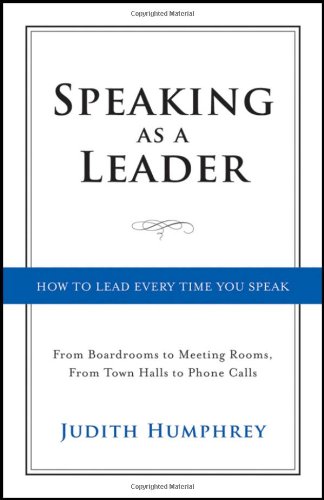
Why did I choose this resource?
Kevin selected this book for me to help improve my abilities to speak in public.
What did you learn from it?
I learned that opportunities to lead and inspire are everywhere; in presentations, conversations, voice mails, and emails. If there is a person around, there is a stage, and if there is a stage, you have a chance to lead and motivate.
Key Knowledge
THE LEADERSHIP MODEL
- STEP ONE: Think as a Leader
- Speak with an idea that is focused, positive, attainable, and encompassing
- You can lead from all levels in a company. The difference is in the approach.
- Be an inspirational speaker not just an informative one, always have a message or vision that drives your talk.
- Listening is key to being a leader; three ways to listen – physically, mentally, and emotionally.
- STEP TWO: Create a Leader’s Script
- Use The Leader’s Script template for all communications, formal and informal, ensures you will always speak as a leader.
- Three main parts:
- The Introduction
- The Grabber – Draws in the audience and excites them about your message, can be personal or literary.
- Personal – the “I” grabber, tells something about yourself
- Literary – many forms such as anecdotes, quotations, statistics, research, short videos, or poetic openings.
- The Subject – Set’s the stage for you discussion and is extremely important to get it right. The subject should be one single exciting topic that has been carefully chosen and redefined,
- The Message – Most important part of the script. Explains to your audience why they are there.
- A Structural Statement – Last sentence of the introduction that sets the course for the body.
- The Grabber – Draws in the audience and excites them about your message, can be personal or literary.
- The Body – Clear, organized arguments that support the main message
- No topics, only arguments
- All points must tie back to the main message
- The structure should allow you to expand or contrast on topics depending on the time available
- Create a structure, and follow it.
- The Conclusion
- Restate the Message
- Call to Action – Informs the listeners or yourself of the actions needed to bring the vision to life.
- The Introduction
- STEP THREE: Use the Language of Leadership
- Think before you speak, stay on topic, be precise, be succinct, use speech appropriate for your audience, and avoid jargon, terms and phrases that have lost meaning.
- Address the audience in a kind and welcoming manner. Do not talk at or down to them.
- Be personal and create a relationship with the audience by using “I,” “you” and “we.”
- Use figures of speech to influence the audience to listen and act.
- Do not lessen the conviction of you speech with beginning a sentence with something similar to, “It’s only my opinion..” or “I’m not sure…”
- Avoid words such as probably, hopefully, just, maybe, primarily, basically, sort of, quite and so on.
- When there is a pause, do not fill it with words like um, ah, you know, to be honest, and like.
- Avoid verbs similar to I think, I suppose, I’d guess and I’ll try.
- Don’t apologize, correct yourself, or end a sentence with “et cetera.”
- STEP FOUR: Achieve a Leader’s Presence
- Engage the audience.
- Use the volume and tone of your voice to emphasize the important parts of your speech. Do not be monotone.
- Avoid visual aids because they are a distraction. You are the best visual for the audience.
- Always speak loudly and cleanly.
How are you using what you learned?
I will use this information to prepare my presentations on my summaries. I will also use it to improve my emails and voice mails to clients. Additionally, I will use it every day to lead and inspire.
Key Changes / Key Actions
- Think before you speak.
- Create outlines for presentations
- Listen to your audience
Source
- Name : Speaking as a Leader
- Book: Speaking as a Leader: How to Lead Every Time You Speak — From Boardrooms to Meeting Rooms, From Town Halls to Phone Calls
- Author : Judith Humphrey
- Summary.com: Link to Book




